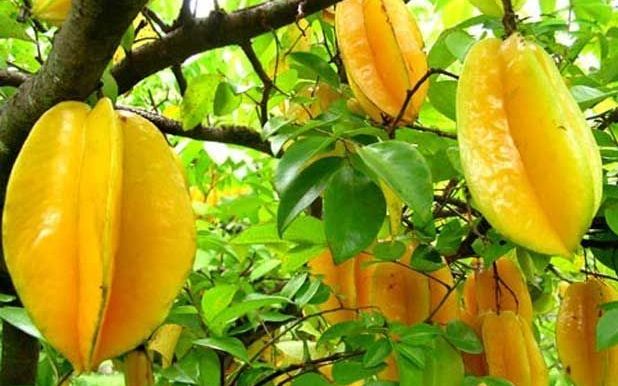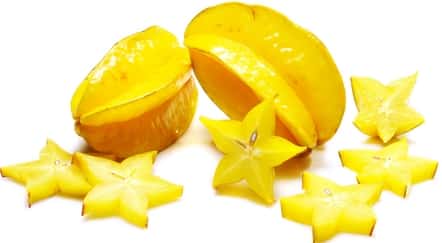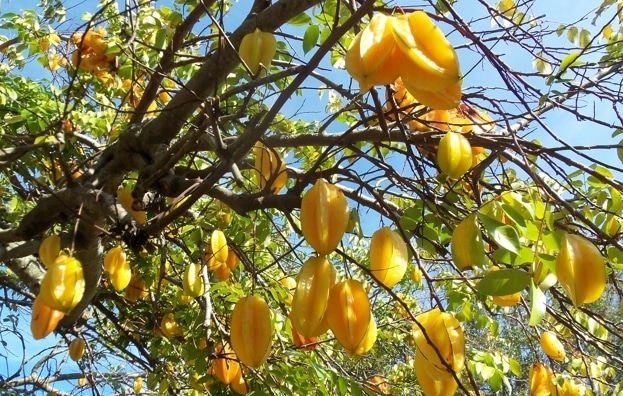Star Fruit Farming Guide:

Introduction of Star Fruit: – Star fruit is a small to medium sized juicy tropical exotic fruit and native to Indonesia, Malaysia and southern China. This fruit has oxalic acid in it and because of this, it is acidic in nature. However, based on variety, this can be sweet or sour fruit. The star fruit tastes like combination of grape, apple & citrus flavors. This fruit has crispy texture. This fruit can be eaten fresh or used in salads. Star fruit is also known as “carambola” and it is a small tree with drooping branches and produces golden yellow oval shaped fruits. This fruit can be cultivated commercially or it’s perfect for your back yard. Usually this fruit shape is like star with ribbed structure measuring about 12 cm in length.
Health Benefits of Star Fruit: – Below listed are some of the health benefits of Star fruit.
- Star fruit is a low calorie fruit.
- Star fruit is a good source of dietary fiber.
- Star fruit is a good source of vitamin-A, vitamin-C & B-complex.
- Star fruit is a source of antioxidants.
- Star fruit helps in curing hangovers & prickly heat.
- Star fruit may help in lowering cholesterol levels.
- Star fruit leaves and roots may help in curing chickenpox, ringworms & headaches.
- Star fruit may help nursing mothers by stimulating the flow of milk.

Star Fruit Local Names in India:- Carambola, Star fruit (English), Kamrakh (Hindi and Gujarati), Kamranga (Bengali), Karambal (Marathi and Konkani), Karambal-drakshi, Kaparakshi hannu (Kannada), Chaturappuli, Vairappuli (Malayalam), Karmanga (Oriya), Thambaratham (Tamil), Ambanamkaya (Telugu),Kordoi, Rohdoi (Assamese).
Major Types/Varieties of Star Fruit in India:- There are no improved varieties cultivated in India, but sweet type and sour type of star fruits can be found. Improved sweet varieties are available in Hawaii, Taiwan. Sweet fruits can be eaten fresh & sour fruits can be used for making pickling or a substitute for tamarind.
Climate Requirement in Star Fruit Farming:- Star fruit trees grow well warm climate with moist content. This fruit crop can be cultivated in India on the hills.(up to 1,200m height). Well distributed rainfall throughout its growth would result in good quality and better yield.
Soil Requirement for Star Fruit Farming:- Star fruit can be cultivated on wide range of soils. However, deep soils with good organic matter and good drainage are best for its cultivation and yield. This fruit can be grown both in alkaline & acidic soils, but it prefers moderately acid soil of pH range 5.5 to 6.5. As these trees can be grown on calcareous soils, sometimes it demands zinc application.
Propagation in Star Fruit Farming:- Grafting, budding & layering are recommended, even though this tree is often propagated through seeds. The reason being is to produce true type plants. Seeds should be sown fresh as they have very low viability. Seeds should be cleaned, dried and sown in plastic bags and allow hardening the seeds. Seedlings should be transplanted in the main land. If the rootstocks are to be used, make sure to have at least a year old to transplant in the field. Grafting or budding should be carried on these.
Spacing in Star Fruit Farming:- Usually a distance of 8 meter x 8 meter should be maintained between plants.
Irrigation in Star Fruit Farming:- Carry out an irrigation immediately after transplanting the star fruit plant into the main field. Young plants may require frequent irrigations until they establish in the field. In case of prolonged dry and hot conditions, supply the water as needed. In rainy season, it does not require any irrigation. In case of heavy rains or flooding, make sure to provide good water drainage as these trees are sensitive to water logging.
Weed Control in Star Fruit Farming:- This crop may require couple of weeding. For appropriate weedicides, contact your local agriculture office.
Training & Pruning in Star Fruit Farming:- There is no specific pruning or training method recommended in star fruit farming.
Manures and Fertilizers in Star Fruit Farming:- This fruit crop requires good organic matter. Applying well rotten farm yard manure of 50 kg per tree will result in good quality of fruits and better yield. There is no specific fertilizer dosage is advocated. However, apply nitrogen (N) and phosphatic fertilizers for good growth of the trees. The dose of these fertilizers depends on the soil fertility and age of the trees. Contact nearest horticulture or agriculture department for recommended dose of fertilizers.
Pests and Diseases in Star Fruit Farming:- Leaf spot, black spot, anthracnose, flyspeck, root rot, and algal disease are the common diseases found in star fruit farming. For control measures, contact your local horticulture or agriculture department.
Harvesting in Star Fruit Farming:- Grafted trees will be ready for harvesting the fruits in 1 to 2 years where as seedling can take about 4 years. These trees bloom and bear fruits even on trunks. Usually, these trees bear fruits all around the year but peak stage is during Jan to Feb & Sept to Oct months. Fruits are ready to harvest when they turn from green to yellow in colour. Hand picking is recommended.

Yield of Star Fruit:- In star fruit farming, yield varies depending upon variety grown, age of the tree. An average of 80 to 90 kg/fully grown tree can be obtained.
For Sheep and Goat Farming Info : Read Here.
Mr. Reddy, Happen to get into this page and noted your interest. I’m looking for a variety of fresh fruits from India.